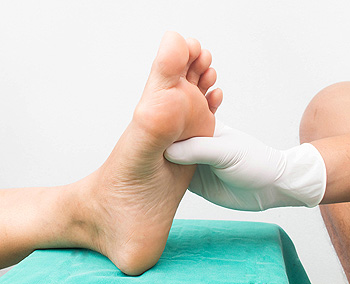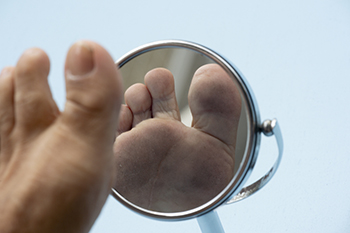Items filtered by date: September 2024
Causes and Symptoms of a Sprained Ankle

An ankle sprain occurs when one or more ligaments in the ankle stretch or tear due to an unnatural twisting or rolling motion. This type of injury often happens during physical activities such as running, jumping, or even stepping on uneven ground. The ligaments, which normally provide stability by holding the ankle bones together, become damaged when they are forced beyond their normal range of motion. Common symptoms of an ankle sprain include pain, swelling, bruising, and difficulty bearing weight on the affected foot. In more severe cases, you may notice instability in the joint or hear a popping sound at the time of injury. Risk factors for sprained ankles include previous ankle injuries, weak muscles, or participating in high-impact sports. A podiatrist plays a key role in diagnosing the severity of the sprain, recommending treatment, and helping you prevent future injuries by strengthening the ankle. If you have sprained an ankle, it is suggested that you make an immediate appointment with a podiatrist for an exam, diagnosis, and treatment options.
Although ankle sprains are common, they aren’t always minor injuries. If you need your ankle injury looked at, contact Donald Manger, DPM from Associated Podiatric Physicians, PA. Our doctor can provide the care you need to keep you pain-free and on your feet.
How Does an Ankle Sprain Occur?
Ankle sprains are the result of a tear in the ligaments within the ankle. These injuries may happen when you make a rapid shifting movement while your foot is planted. A less common way to sprain your ankle is when your ankle rolls inward while your foot turns outward.
What Are the Symptoms?
- Pain at the sight of the tear
- Bruising/Swelling
- Ankle area is tender to touch
- In severe cases, may hear/feel something tear
- Skin discoloration
Preventing a Sprain
- Wearing appropriate shoes for the occasion
- Stretching before exercises and sports
- Knowing your limits
Treatment of a Sprain
In many cases, the RICE method (Rest, Ice, Compression, and Elevate) is used to treat ankle sprains. However, you should see a podiatrist to see which treatment option would work best with your injury. In severe cases, surgery may be required.
It is important to ask your doctor about rehab options after you receive treatment for your injury. Stretching, strength training, and balance exercises may help the ankle heal while also preventing further injury.
If you have any questions, please feel free to contact our office located in Hamilton Township, NJ . We offer the newest diagnostic and treatment technologies for all your foot care needs.
Managng Foot Blisters

Blisters are small fluid-filled bubbles that typically form on the skin as a result of friction or pressure, often from wearing new or tight shoes. These bubbles develop when repeated rubbing causes the top layers of skin to separate. This allows fluid to accumulate in the space created. While friction is the most common cause of blisters, they can also arise from burns, sunburn, insect bites, and certain medical conditions. Symptoms include a raised area of skin filled with clear fluid or blood, along with redness, pain, and itching. Blisters can be painful and may become infected if not properly treated. Popping a blister is not recommended as it can lead to infection. A podiatrist can safely treat blisters on the feet, ensuring that any underlying causes are identified and addressed. If you have a problematic blister on the foot, it is suggested that you schedule an appointment with a podiatrist for an exam and treatment options.
Blisters may appear as a single bubble or in a cluster. They can cause a lot of pain and may be filled with pus, blood, or watery serum. If your feet are hurting, contact Donald Manger, DPM of Associated Podiatric Physicians, PA. Our doctor can provide the care you need to keep you pain-free and on your feet.
Foot Blisters
Foot blisters are often the result of friction. This happens due to the constant rubbing from shoes, which can lead to pain.
What Are Foot Blisters?
A foot blister is a small fluid-filled pocket that forms on the upper-most layer of the skin. Blisters are filled with clear fluid and can lead to blood drainage or pus if the area becomes infected.
Symptoms
(Blister symptoms may vary depending on what is causing them)
- Bubble of skin filled with fluid
- Redness
- Moderate to severe pain
- Itching
Prevention & Treatment
In order to prevent blisters, you should be sure to wear comfortable shoes with socks that cushion your feet and absorb sweat. Breaking a blister open may increase your chances of developing an infection. However, if your blister breaks, you should wash the area with soap and water immediately and then apply a bandage to the affected area. If your blisters cause severe pain it is important that you call your podiatrist right away.
If you have any questions, please feel free to contact our office located in Hamilton Township, NJ . We offer the newest diagnostic and treatment technologies for all your foot care needs.
Arthritis Can Cause Pain in the Feet and Ankles
Effective Diabetic Foot Care

Good diabetic foot care is vital for preventing complications and maintaining overall health. Regular inspection of the feet is crucial, as diabetes can reduce sensation and make it difficult to notice injuries or changes. Feet should be washed daily with mild soap and water, and thoroughly dried, especially between the toes, to prevent fungal infections. Moisturizing the feet helps to prevent dryness and cracking, but should avoid the areas between the toes. Wearing properly fitted shoes is essential to prevent blisters and sores, and routine checks by a podiatrist can catch potential issues early. It is important to avoid walking barefoot to reduce the risk of injury. Additionally, managing blood sugar levels effectively contributes to better foot health. If you have diabetes, it is strongly suggested that you are under the care of a podiatrist who can routinely provide foot health checks, and help you to manage this condition.
Diabetic foot care is important in preventing foot ailments such as ulcers. If you are suffering from diabetes or have any other concerns about your feet, contact Donald Manger, DPM from Associated Podiatric Physicians, PA. Our doctor can provide the care you need to keep you pain-free and on your feet.
Diabetic Foot Care
Diabetes affects millions of people every year. The condition can damage blood vessels in many parts of the body, especially the feet. Because of this, taking care of your feet is essential if you have diabetes, and having a podiatrist help monitor your foot health is highly recommended.
The Importance of Caring for Your Feet
- Routinely inspect your feet for bruises or sores.
- Wear socks that fit your feet comfortably.
- Wear comfortable shoes that provide adequate support.
Patients with diabetes should have their doctor monitor their blood levels, as blood sugar levels play such a huge role in diabetic care. Monitoring these levels on a regular basis is highly advised.
It is always best to inform your healthcare professional of any concerns you may have regarding your feet, especially for diabetic patients. Early treatment and routine foot examinations are keys to maintaining proper health, especially because severe complications can arise if proper treatment is not applied.
If you have any questions please feel free to contact our office located in Hamilton Township, NJ . We offer the newest diagnostic and treatment technologies for all your foot and ankle needs.
Prevention of Diabetic Foot Infections

Preventing diabetic foot infections is imperative for individuals with diabetes, as they are more prone to sores and wounds on their feet. High blood sugar levels can damage nerves, leading to neuropathy, and reduce blood flow, making it harder for injuries to heal and increasing the risk of infection. Without proper care, even small cuts or blisters can develop into serious infections. To prevent these issues, diabetic patients should perform daily foot inspections, checking for any cuts, redness, or swelling. Moisturizing regularly can help to prevent dry, cracked skin that can become infected. Wearing properly fitting shoes that do not cause pressure points or blisters is essential, as is keeping feet clean and dry. Avoiding extreme temperatures protects against burns or frostbite, which can go unnoticed due to nerve damage. Nails should be cut straight across to prevent ingrown nails, which can also become infected. If you have diabetes, it is strongly suggested that you make regular appointments with a podiatrist to manage your foot health and address any concerns before they escalate.
Wound care is an important part in dealing with diabetes. If you have diabetes and a foot wound or would like more information about wound care for diabetics, consult with Donald Manger, DPM from Associated Podiatric Physicians, PA. Our doctor will assess your condition and provide you with quality foot and ankle treatment.
What Is Wound Care?
Wound care is the practice of taking proper care of a wound. This can range from the smallest to the largest of wounds. While everyone can benefit from proper wound care, it is much more important for diabetics. Diabetics often suffer from poor blood circulation which causes wounds to heal much slower than they would in a non-diabetic.
What Is the Importance of Wound Care?
While it may not seem apparent with small ulcers on the foot, for diabetics, any size ulcer can become infected. Diabetics often also suffer from neuropathy, or nerve loss. This means they might not even feel when they have an ulcer on their foot. If the wound becomes severely infected, amputation may be necessary. Therefore, it is of the upmost importance to properly care for any and all foot wounds.
How to Care for Wounds
The best way to care for foot wounds is to prevent them. For diabetics, this means daily inspections of the feet for any signs of abnormalities or ulcers. It is also recommended to see a podiatrist several times a year for a foot inspection. If you do have an ulcer, run the wound under water to clear dirt from the wound; then apply antibiotic ointment to the wound and cover with a bandage. Bandages should be changed daily and keeping pressure off the wound is smart. It is advised to see a podiatrist, who can keep an eye on it.
If you have any questions, please feel free to contact our office located in Hamilton Township, NJ . We offer the newest diagnostic and treatment technologies for all your foot care needs.

